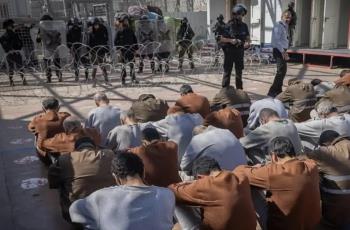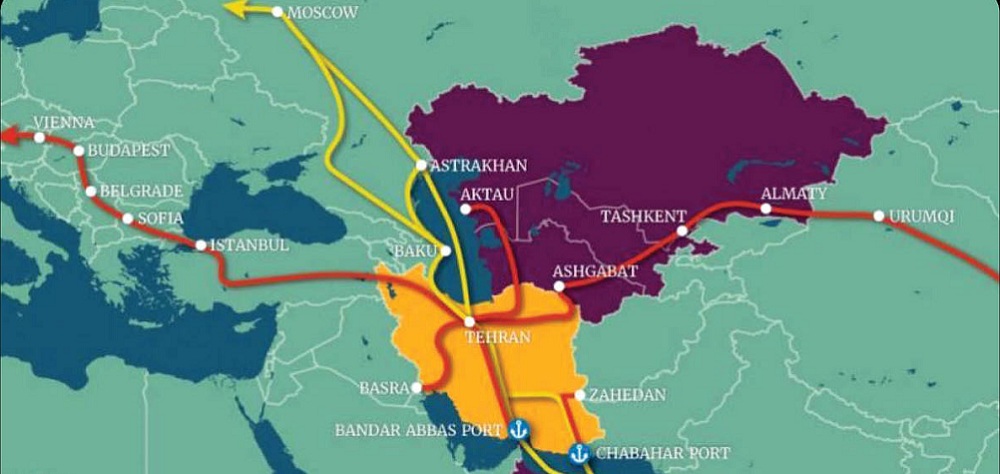Alwaght- The railway infrastructural projects are attractive for countries due to their linking potentials, providing economic opportunities in ports, cutting transportation costs, and allowing people access to trade and business opportunities. The big powers that seek boost their position on the world stage have focused on attractive rail routes more than others in recent years.
To realize its trade and economic policies, the administration of President Sayyed Ibrahim Raeisi of Iran is cooperating with some regional countries to use the railway capacities to boost international trade routes.
Currently, the most important corridor under Iran's implementation is the North-South Corridor, which has gained an acceptable momentum following the developments caused by the war in Ukraine, and its full operationalization can play an important role in upgrading Iran's position in the world trade network.
However, concentration on North-South Corridor has not distracted the Iranian administration from activating the country’s other transit capacities. Oil Price outlet in an analysis holds that an Iranian-Indian-Armenian triangle is emerging. This triangle, the outlet adds, can carry a strategic message and transform the geopolitical balance in South Caucasus. The report says that the first tripartite political consultation between the deputy foreign ministers of Iran, India and Armenia was held in April in Yerevan. In these talks, the three countries focused primarily on "economic issues and regional communication channels" and "the parties agreed to continue consultations in a tripartite format.” The growing cooperation between Iran, Armenia and India can be part of Tehran's effort to restore balance in the South Caucasus after the second Karabakh war, and this tripartite group is different from the tripartite bloc of Pakistan, Turkey and Azerbaijan.
The goal behind the proposed corridor, which will be constructed parallel to the North-South Corridor, is linking Mumbai to Bandar Abbas and then Armenia, and from there Europe or Russia. $250 billion worth of Indian, Chinese and East Asian products will be transited to Europe from this corridor annually and Iran's share in goods transit is expected to be around 4 percent. This means that Iran's share of goods transit in this corridor will be $10 billion a year, and the establishment of this corridor will have a 15-percent influence on the national Iranian GDP in the long term. Therefore, launching this transit route along the North-South corridor can offer considerable contribution to Iran's growing economy.
With experience having proven that international railway construction is time-taking, the conditions are more provided for fast launch of Persian Gulf-Black Sea more prepared, as inside Iran, which is the main ground of this corridor, the infrastructure is already constructed. Port of Chabahar of Iran is a significant trade bridge for the three countries as it provides direct access to the Indian Ocean. In recent years, the Indians have invested in this port to facilitate exports to Central Asia and Russia. Chabahar Port has the capacity to play role of a gate for India’s access to Central Asia, Caucasus, and Europe. These two corridors, thus, play a key role together.
With the construction of the Persian Gulf-Black Sea railway, Iran can become a commercial hub in the region and, if connected to other transit routes, a commercial hub in the world. Georgia, which is part of the missing link of the Persian Gulf-Black Sea corridor, has railways and ground routes with Armenia, and will help a lot in the rapid construction of this megaproject.
Persian Gulf-Black Sea corridor beneficial to India
The Persian Gulf-Black Sea corridor very well rhymes with Indian plans because New Delhi looks for additional routes to reach Europe, circumvent Suez Canal, and avoid negative impacts of Russian-Western confrontation. Having in mind that transfer of Indian goods from the Red Sea and the Mediterranean to Europe takes a lot of money and time, New Delhi leaders are trying to choose shorter and more economical routes, and the Persian Gulf-Black Sea corridor has been chosen for this purpose. If realized, it can facilitate India's trade with other countries.
Due to its competition with China for trade with the West, India is trying to use the railway corridors to develop its international trade so as not to fall behind in the race for higher global trade rank.
The new corridor, which complements the North-South Corridor, with Indian investments, can help boost the transit routes. India has used the North-South Corridor in the past year to export its goods to Russia, and this cooperation is strengthening day by day.
Iran's push to make balance in Caucasus
In recent years, Iran played an important role in establishment of rail corridors in Asia as it is a bridge between the East and the West. In response to some destructive actions that challenge these rail routes, Iran tries to make a transit corridor balance. In the North-South Corridor, which was launched last year, Iran has the role of facilitating trade from Russia to the Indian Ocean. Nevertheless, it is trying to diversify its rail routes so that regional trade is not disrupted in case of crisis.
With Azerbaijan in recent years causing tensions in the region and pushing for construction of the controversial Zangezor corridor that cuts off Iran-Armenia links, Iran is working on Persian Gulf-Black Sea corridor to involve other countries in Caucasus and block geopolitical changes to the region.
Since part of this new corridor crosses Iranian and Armenian borders, with participation of India and other countries like Georgia, and even Europeans in this project, pressures would mount on Azerbaijan for cutting off railways in the future and the issue would take international aspects, and Baku officials will face serious challenges to their ambitious plans. In recent years, India has established extensive defense relations with Armenia and does not want to lose its profitable trade market in the Caucasus. According to Oil Price, due to the change in the balance of power in the South Caucasus after the second Karabakh war and the Russia-Ukraine war, Armenia and India intend to be more active in both North-South and Persian Gulf-Black Sea corridors.
Another issue is that despite being part of North-South Corridor, Azerbaijan may put the skids under trade from this corridor due to its political differences with Iran. Therefore, Iran can use the Persian Gulf-Black Sea corridor as a guaranteeing card because in the new route, Azerbaijan is excluded and Iran replaces it with Armenia and Georgia to avoid disruptions in transit to Europe.
On the opposite side, to circumvent Iran's rail routes, Azerbaijan and Turkey are seeking to construct their Trans-Caspian railway that links Central Asia to Caucasus. This plan is backed by China. In response, Iran is using its internal capacity to launch its own corridors in association with its partners. Iran's transit routes are more economical than similar options in the region and are more secure due to the ground route. Also, there is a long time until the construction of the ambitious project of Turkey and Azerbaijan, which may take decades. But with the help Indian and Armenian help, Tehran can launch the new routes in the shortest possible time and at a lower cost.
In general, the Iranian strategy to develop its railway infrastructure and expand its trade with other countries will help uplift its global trade position, and this indicates that the American policy to isolate Tehran has met its failure, and world powers count on Iran's transit routes to advance their major programs.



























